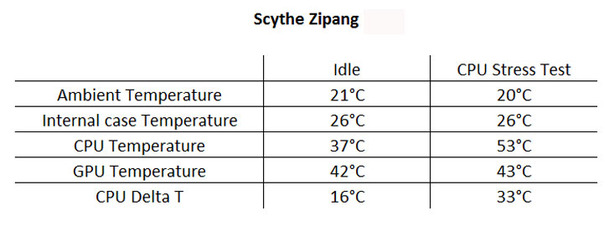
Testing
As per usual, we fitted the Scythe Zipang onto our notoriously toasty test system and mounted it into our heatsink testing chassis, a Lancool Metal Boned K7. This case uses a fairly standard front to back dual 120mm intake / solo 120mm exhaust cooling setup to cool our hardware, and we feel represents an “average” home cooling setup.Following our standard heatsink testing methodology, we then run idle and CPU stress tests three times, including fully re-fitting the heatsink between tests to ensure we eliminate any potentially erroneous results caused by variables in the mounting process. These variables could include differences in the tension of the mounting bracket, consistency and amount of thermal paste applied or improper mounting and can seriously compromise the accuracy of test results.
We use the results from the three separate test runs to create a set of average temperatures - that's exactly what you're seeing here in our results tables. We order our results based on the delta T value of the CPU under load – this means the difference between the ambient temperatures that we tested in, and the highest CPU temperature recorded.

Complete disappointment is the first thing we can take from the Zipang’s thermal results – its cooling performance is disastrously sub par when compared against almost any other cooler we’ve recently looked at with an enormously disappointing delta T value of 33°C at load and the highest idle delta T we’ve yet seen from an after market cooler at 16°C.
These results are even worse than the last top flow cooler we looked at, the Asus Triton, despite the Zipang’s ridiculous size and heat pipe array. We have to ask the question of what is the point six heatpipes and over 60 cooling fins if the actual cooling delivered is comprehensively beaten by a £12 budget cooler like the Akasa 965?! Scythe lists this product as an overclocking cooler, but we doubt any overclocker would go near an air cooler with such awful thermal performance in comparison to the competition.
With the sheer amount of copper and surface area for cooling, the Scythe Zipang really should be producing much better thermal results, and we feel the blame can be laid on the quality of the cooler at the vital heat transfer points between the base and the heat pipes, and then between the heatpipes and the cooling fins. There are clear gaps around the heatpipes running through the base, and the lower tier of heatpipes only makes limited contact with the cooling fin array, which have obviously reduced thermal performance.
What’s also of concern are the abnormally high case and GPU temperatures, which are usually a good few degrees lower at both idle and load. Because the Zipang is so large, it physically blocks case airflow between the exhaust fan and other components like the graphics card, resulting in poor cooling performance not just for the CPU, but the whole system.
Acoustically though, the Zipang does mercifully deliver entirely silent performance, and is comfortably the quietest cooler we’ve ever tested even with the fan at full speed. It was even quieter than our low noise cooler of choice, the Noctua NH-U12P, although at these low noise levels the difference isn’t that significant.

MSI MPG Velox 100R Chassis Review
October 14 2021 | 15:04








Want to comment? Please log in.